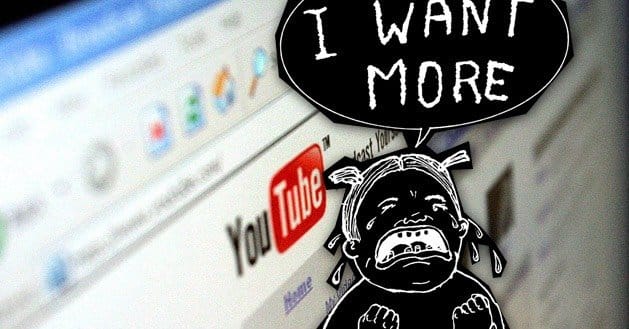 Written by ContentPowered.com
Written by ContentPowered.comYouTube view counts are a seemingly arcane measure of the interest in your video. There are hundreds of thousands of videos with less than ten views, uploaded for a variety of reasons. There are an equal number of videos with millions of views, from popular artists to viral comedies and socially shared beat poetry. Your videos, promoting your business, have serious potential to reach thousands or millions of people. It’s no wonder that marketers are increasingly apt to use YouTube.
That view count, though; what’s the deal? Some videos don’t seem to match the number of outgoing clicks you’ve recorded. Others have their view counts fluctuate up and down. Every one gets stuck at 301+ for days at a time. How does it all work?
From Upload to Sharing
In the old days, a view count was exactly that; a simple indicator of the number of times the video had been loaded. This was a reasonable measure, except it quickly became apparent that everyone – from a teenager sharing a home video to a business sharing a commercial – could simply reload the page over and over, increasing the view count artificially. Because YouTube features a page displaying popular videos, then sorted largely by view count, it was easy for someone to game the system and get a video on the front page. Needless to say, this quickly changed.
Now, when your video has fewer than 300 views, it’s still largely the same. The page increases the view count number each time the video is loaded. It’s a fine system, for low view counts. Even if you monetize your videos through YouTube ads, 300 views won’t get you more than a few pennies. The potential for abuse is minimal at best. For some small businesses, this is enough. The chances of their video surpassing 300 views is minimal at best. For others, 300 can be attained within the day, or even the hour, of the video’s upload.
The 301+ Tipping Point
The 301+ point is the coming of age of a video on YouTube. At 300 views, YouTube freezes the view count automatically. Views are still counted, and the number of likes and dislikes is not affected. Your video can still be viewed and monetized like normal.
What happens while the video view count is frozen? YouTube performs an audit of the existing views. The 300-view point was chosen because videos under that level rarely bothered to game the system, and when they did, it was to little effect. Above 300, the chances of the video to reach a much wider audience grew, and consequently the potential for abuse grew with it.
This audit, essentially, analyzes the sources of the views you’ve obtained thus far. If a significant number of those views all come from the same few locations, they are likely removed. This is to prevent fraud by eliminating the effect of bots refreshing the page to load the video.
Once your view count has been verified, the actual number of views is released and the view count can increase once more. This process can take as long as a day, or as short as an hour, depending on a number of factors in YouTube’s back end.
The Complexity of Increasing Views
Once your view count has been released, your video is given the freedom to rack up as many views as it can sustain. However, the view count algorithm is no longer the same raw page load count as it was before. The video is in the big leagues, and must play by new rules.
YouTube is understandably hesitant to speak about their exact security measures. After all, if the security is known, it can be circumvented. See also: the arms race between black hat SEO and Google. All that can be said is that a smart algorithm is applied in order to detect and eliminate fraudulent views. The old refreshing-the-page tricks don’t work. More importantly, fraudulent views from malware infections and spambots are eliminated as well. After all, YouTube doesn’t want to write a check for ad revenue to a video producer who got their views from a virus loading and reloading the page in the background, unseen and unheard.
YouTube’s Stop and Frisk
From this point on, your video is largely home free. It can be shared, monetized and promoted just as it always could. You’re free to embed it in other sites, share it through social media and ask for subscribers to your channel. You are not, however, completely free of scrutiny.
YouTube is always vigilant for abuse of their system. Despite hiding their security, it can still be circumvented. YouTube now periodically performs random audits on videos, to once more scan and validate the view counts of a particular video. How often these audits occur and how much impact they have is unknown, as the process is both new and unannounced. You would likely only notice it, for that matter, if you track your view counts from day to day. You would, in these cases, likely notice them drop from one day to the next before resuming their climb.
Sources of Illegitimate Views
YouTube has a specific definition of a view. That is, a viewer-initiated, intentional play of a video. Views are aggregated between views on the YouTube page itself, through embedded views in the YouTube player, through mobile devices and other sources of viewing.
Some things that flag a view as potentially fraudulent:
- The video is set to autoplay, particularly when it is embedded on a website.
- The video is reloaded repeatedly in a short amount of time.
- The views come from users known to be run by spambots.
- The views come from malware infections.
- The views are purchased through a third party site.
That last one is the big one. Buying thousands of views may be seen as a way to kick start a new video, but the practice is heavily frowned upon and the views can be removed, thus removing your investment. In fact, YouTube specifically mentions that purchasing views is “downright not allowed” on their policy center page.
Why Fraudulent Views are Harmful
The first reason, which has diminished over the years since YouTube instituted smarter algorithms sorting the popular videos pages, was that fake views had the potential to rocket a video to the top without it legitimately gaining the foundation first. Since YouTube began to offer monetization on their videos, the stakes have grown quite a bit higher.
The main reason is that fake views affect the valuation of a YouTube advertisement. YouTube ads pay per impression and per click, and each of those is given a value. That value is based, in part, on the percentage of people who click versus the people who simply ignore the ad or block it. When fraudulent views are rampant, the ratio changes and advertisements are devalued. Everyone makes less because it requires more views to receive the clicks necessary to pay out. The cycle grows worse when people then pay for more views to further reach those goals, which further deflates the value of the ads.
Buying views is also a risky move for a business. Sure, it can give a temporary jolt to the position of a video, but it’s just that; temporary. YouTube catches those views and removes them, at which point the investment is lost. Sure, the video may have received some additional exposure, but that exposure is minor compared to what it could have had with a legitimate foundation.
Update in 2018
YouTube’s AI has gotten smarter over the years, and you may notice occasional adjustments to your view count throughout the month. This is YouTube automatically reviewing and adjusting your view count to filter out any un-natural or fake views on your video. If you see a drop in your YouTube views, this isn’t necessarily a penalization or a bad thing, but YouTube keeping your view count as accurate as possible. After all, if we couldn’t trust the view count calculations to be accurate, then there wouldn’t be a whole lot of point in them being there in the first place, would they?
What are your thoughts on YouTube views and their calculations? Have yours been accurate lately, or have you had your views removed? Feel free to share in the comments below!



Bernard Pilkinton
says:Good to know. Looks like slow and steady wins the race, especially once you hit that 301+ point
Richard Neva
says:I do not have any videos I produced on Utube at all! Yet that number on my site is 5,120 Views, now what on earth does that mean????? I just post a few things of importance to me, like photos and such.